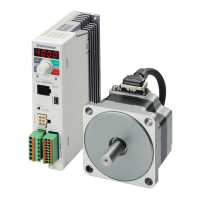Operation
−39−
8.9 Multi-motor control
To operate two or more motors at the same speed using a single external potentiometer (external DC voltage) is
called multi-motor control.
Multi-motor control is achieved by allowing multiple drivers to share the power line and speed setting line.
•
To perform multi-motor control using the external potentiometer, set the basic function switch (SW1-No.2) to OFF.
•
Set the basic function switch (SW1-No.2) to the same setting for all drivers.
Using an external potentiometer
Connect the drivers as shown below.
When performing multi-motor control using the external potentiometer, the number of drivers should not exceed
20units.
470 Ω
1/4 W
VRn
1 kΩ
1/4 W
External potentiometer
VRx
13
2
Driver 1 Driver n
VM
VL
VH
VM
VL
VH
+
Power line
Resistance (VRx) when the number of drivers is n:
Resistance (VRx) = 20/n (k
Ω
), n/4 (W)
Example: If two drivers are used
Resistance (VRx) = 20/2 (k
Ω
), 2/4 (W), resistance (VRx) is calculated as 10 k
Ω
, 1/2 W.
(Use a resistor of the calculated wattage or more.)
If the speed will vary among the respective motors, make adjustments by connecting a resistor of 470
Ω
, 1/4 W to the
VM terminal on driver 1 and connecting a variable resistor VRn of 1 k
Ω
, 1/4 W to driver 2 and subsequent drivers.
Using external DC voltage
Connect the drivers as shown below.
0 to 5 VDC
or
0 to10 VDC
470 Ω
1/4 W
VRn
1 kΩ
1/4 W
Driver 1 Driver n
VM
VL
VH
VM
VL
VH
Power line
+
Calculation method of current capacity (I) of external DC power supply when the number of drivers is n:
Current capacity (I) = 1
×
n (mA)
Example: If two drivers are used
Current capacity (I) = 1
×
2 (mA), current capacity (I) is calculated as 2 mA or more.
If the speed will vary among the respective motors, make adjustments by connecting a resistor of 470
Ω
, 1/4 W to the
VM terminal on driver 1 and connecting a variable resistor VRn of 1 k
Ω
, 1/4 W to driver 2 and subsequent drivers.

